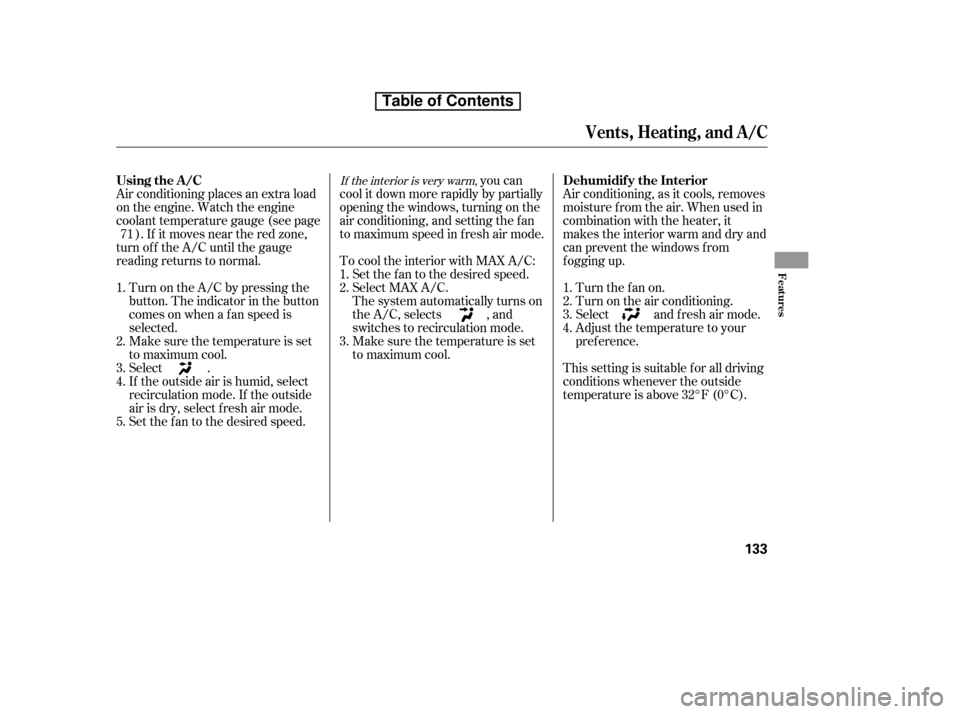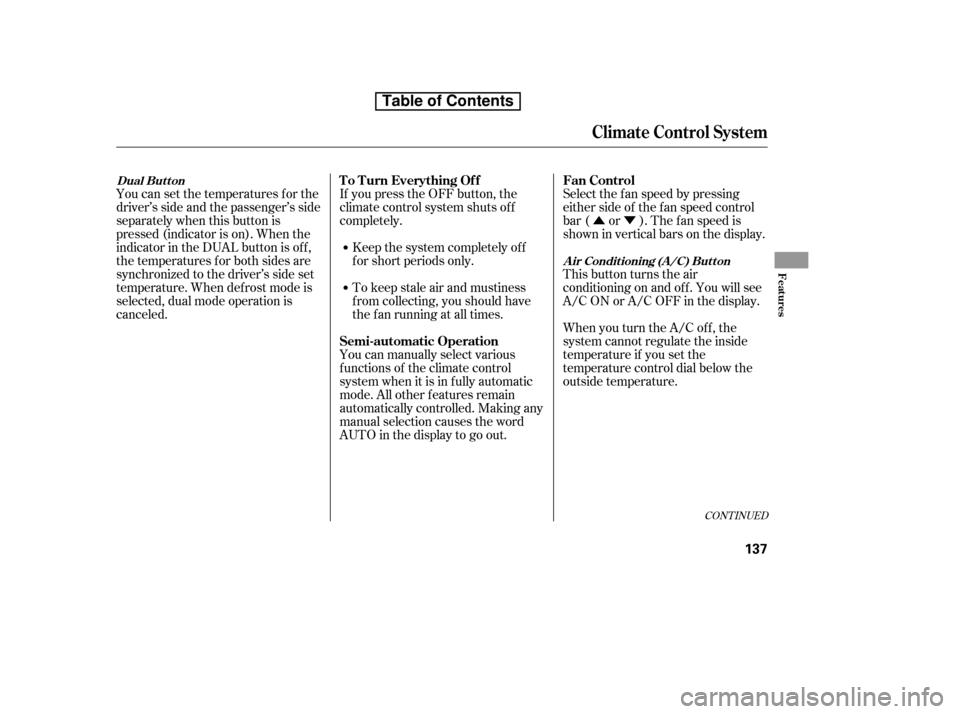Page 148 of 441

Air conditioning places an extra load
on the engine. Watch the engine
coolant temperature gauge (see page). If it moves near the red zone,
turn of f the A/C until the gauge
reading returns to normal.
Turn on the A/C by pressing the
button. The indicator in the button
comesonwhenafanspeedis
selected.
Make sure the temperature is set
to maximum cool.
Select .
If the outside air is humid, select
recirculation mode. If the outside
air is dry, select f resh air mode.
Set the f an to the desired speed. you can
cool it down more rapidly by partially
opening the windows, turning on the
air conditioning, and setting the f an
to maximum speed in f resh air mode.
To cool the interior with MAX A/C: Set the f an to the desired speed.
Select MAX A/C.
The system automatically turns on
the A/C, selects , and
switches to recirculation mode.
Make sure the temperature is set
to maximum cool. Air conditioning, as it cools, removes
moisture from the air. When used in
combination with the heater, it
makes the interior warm and dry and
can prevent the windows f rom
f ogging up.
This setting is suitable f or all driving
conditions whenever the outside
temperature is above 32°F (0°C).
Turn the fan on.
Turn on the air conditioning.
Select and fresh air mode.
Adjust the temperature to your
pref erence.
1. 2. 3. 4. 5. 1. 2.3.4.
1.2. 3.
71
If the interior is very warm,Dehumidif y the Interior
Using the A /C
Vents, Heating, and A/C
Features
133
Table of Contents
Page 150 of 441
Climat e Cont rol Syst em
Features
135
EX-L modelRECIRCULATION
BUTTON MODE BUTTON
DRIVER’S SIDE
TEMPERATURE
CONTROL DIAL
AUTO
BUTTON
OFF
BUTTON
FAN CONTROL
BAR AIR CONDITIONING
BUTTON
PASSENGER’S SIDE
TEMPERATURE
CONTROL DIAL
REAR WINDOW
DEFOGGER/MIRRORS
HEATER BUTTON
WINDSHIELD
DEFROSTER BUTTON
DUAL BUTTON
Table of Contents
Page 151 of 441

On vehicles with navigation systemThe automatic climate control
system in your vehicle maintains the
interior temperature you select. The
system also adjusts the f an speed
and airf low levels.The driver’s side temperature and
the passenger’s side temperature can
be set separately. Turn the dial of
the appropriate temperature control
clockwisetoincreasethe
temperature of airf low. Turn the dial
counterclockwise to decrease it.
Each set temperature is shown in the
display.
When you set the temperature to its
lower limit ( ) or its upper limit
( ), the system runs at f ull
cooling or heating only. It does not
regulate the interior temperature.
When the indicator in the dual
button is on, the driver’s side and
passenger’s side temperature can be
controlled independently (see page
).
The climate control system f or your
vehicle can also be operated using
the voice control system. See the
navigation system manual f or
complete details.
Press the AUTO button.
Set the desired temperature by
turning the driver’s side
temperature control dial. You will
see AUTO and the selected
temperature in the display. You
can also set the passenger’s side
temperature by turning the
passenger’s side dial.
The system automatically selects the
proper mix of conditioned and/or
heated air that will, as quickly as
possible, raise or lower the interior
temperature to your pref erence.
1. 2.
140
Climat e Cont rol Syst em
Voice Control System Using A utomatic Climate ControlT emperat ure Cont rol
136
Table of Contents
Page 152 of 441

�Û�Ý
You can set the temperatures for the
driver’s side and the passenger’s side
separately when this button is
pressed (indicator is on). When the
indicator in the DUAL button is of f ,
the temperatures for both sides are
synchronized to the driver’s side set
temperature. When def rost mode is
selected, dual mode operation is
canceled. If you press the OFF button, the
climate control system shuts of f
completely.
Keep the system completely of f
f or short periods only.
To keep stale air and mustiness
f rom collecting, you should have
the f an running at all times.
You can manually select various
f unctions of the climate control
system when it is in f ully automatic
mode. All other f eatures remain
automatically controlled. Making any
manual selection causes the word
AUTO in the display to go out. Select the f an speed by pressing
either side of the f an speed control
bar ( or ). The f an speed is
showninverticalbarsonthedisplay.
This button turns the air
conditioningonandoff.Youwillsee
A/C ON or A/C OFF in the display.
When you turn the A/C of f , the
system cannot regulate the inside
temperature if you set the
temperature control dial below the
outside temperature.
CONT INUED
Climat e Cont rol Syst em
Dual Button
A ir Condit ioning (A /C) But t onTo Turn Everything Of f
Semi-automatic OperationFan Control
Features
137
Table of Contents
Page 153 of 441

When the indicator in the button is
on, air f rom the vehicle’s interior is
sent through the system again.
When the indicator is off, air is
brought in f rom the outside of the
vehicle (fresh air mode).
The outside air intakes f or the
climate control system are at the
base of the windshield. Keep this
area clear of leaves and other debris.
Thesystemshouldbeleftinfresh
air mode under almost all conditions.
Keeping the system in recirculation
mode, particularly with the A/C of f ,
can cause the windows to fog up.
Switch to recirculation mode when
driving through dusty or smoky
conditions, then return to fresh air
mode.Pushing this button also turns the
power mirror heaters on and of f .
This button turns the rear window
def ogger of f and on (see page ).
Use the mode control button to
select the vents the air flows from.
Some air will flow from the
dashboard vents in all modes.
Air flows from the center
and corner vents in the dashboard.
Airf low is divided between
the vents in the dashboard and the
f loor vents.
Air f lows f rom the f loor
vents.
Airf low is divided between
the f loor and corner vents and the
defroster vents at the base of the
windshield.
80
Climat e Cont rol Syst em
Recirculat ion But t on Rear Window Def ogger
ButtonMode Cont rol
138
Table of Contents
Page 265 of 441

How well the radio receives stations
is dependent on many f actors, such
as the distance from the station’s
transmitter, nearby large objects,
and atmospheric conditions.
The radio can receive the complete
AM and FM bands.
Those bands cover these f requen-
cies:
AM band: 530 to 1,710 kHz
FM band: 87.7 to 107.9 MHz
Driving very near the transmitter of
a station that is broadcasting on a
f requency close to the f requency of
the station you are listening to can
also af f ect your radio’s reception.
You may temporarily hear both
stations,orhearonlythestationyou
are close to.
A radio station’s signal gets weaker
as you get f arther away f rom its
transmitter. If you are listening to an
AM station, you will notice the sound
volume becoming weaker, and the
stationdriftinginandout.If youare
listening to an FM station, you will
see the stereo indicator f lickering of f
and on as the signal weakens.
Eventually, the stereo indicator will
go of f and the sound will f ade
completely as you get out of range of
the station’s signal.
Radio stations on the AM band are
assigned f requencies at least 10 kHz
apart (530, 540, 550). Stations on the
FM band are assigned f requencies at
least 0.2 MHz apart (87.9, 88.1, 88.3).
Stations must use these exact
f requencies. It is f airly common f or
stations to round-of f the f requency in
their advertising, so your radio could
display a f requency of 100.9 even
though the announcer may identif y
the station as ‘‘FM101.’’ Radio Reception
Radio Frequencies
A M/FM Radio Recept ion
250
Table of Contents
Page 315 of 441

�µ�µ�µ �µ
�µ
�µ
Aggressive driving (hard
acceleration and braking)
Excessive idling, accelerating and
braking in stop-and-go traf f ic
Cold engine operation (engines
aremoreefficientwhenwarmedup)
Driving with a heavy load or the
air conditioner running
Improperly inf lated tires
The f ollowing f actors can lower your
vehicle’s f uel economy:
A properly maintained vehicle
maximizes f uel economy. Poor
maintenance can signif icantly reduce
f uel economy. Always maintain your
vehicle according to the maintenance
messages displayed on the multi-
inf ormation display (see
on page ).
For example: An underinf lated tire increases
‘‘rolling resistance,’’ which reduces
f uel economy.
It puts a heavier
load on the engine, increasing f uel
consumption.
In
particular, a build-up of snow or
mud on your vehicle’s underside
adds weight and rolling resistance.
Frequent cleaning helps your f uel
economy. Aerodynamic drag has a big ef f ect
on f uel economy at speeds above
45 mph (75 km/h). Reduce your
speed and you reduce the drag.
Trailers, car top carriers, roof
racks and bike racks are also big
contributors to increased drag.
Rapid
acceleration, abrupt cornering,
and hard braking increase fuel
consumption.
Idling
results in 0 miles per gallon (0 kms
per liter).
346
Fuel Economy Factors Use the recommended viscosity
motor oil, displaying the A PI
Certif ication Seal (see page).
Improving Fuel Economy Owner’s
Maintenance Checks Maintain proper tire inf lation
A void carrying excess weight in
your vehicle
K eep your vehicle clean
Observe the speed limit
Drive moderately
Avoid excessive idling
349
Vehicle Maint enance Drive Ef f icient ly
Fuel Economy
300
Table of Contents
Page 316 of 441
�µ�µ
Fill the f uel tank until the nozzle automatically clicks of f .
Reset trip counter to zero.
Record the total gallons (liters) needed to ref ill.
Follow one of the simple calculations above.
The A/C
puts an extra load on the engine
which makes it use more f uel. Use
the f resh-air ventilation when
possible.
Direct calculation is the
recommended source of inf ormation
about your actual f uel economy.
Using f requency of f ill-ups or taking
f uel gauge readings are NOT
accurate measures of f uel economy.
Fuel economy may improve over the
f irst several thousand miles
(kilometers). Combine several short trips into
one. A warmed-up engine is more
f uel ef f icient than a cold one.
1)2)3)4)
Checking Your Fuel Economy
Measuring T echniquesMinimize the use of the air
conditioning system
Calculating Fuel Economy Plan and combine trips
Fuel Economy
Bef ore Driving
301
Miles
driven Gallons
of fuel Miles per
Gallon
100 KilometersLper
100 km
Liter
Table of Contents